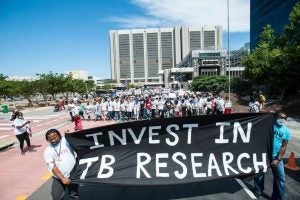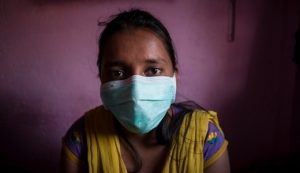
Photo: Treatment Action Campaign
Tuberculosis (TB) is a preventable and treatable disease which kills more people globally than any other infectious disease, approximately 5,000 every day. Despite grim statistics and the plethora of human rights violations that occur in the context of TB, there is inadequate funding, and limited public awareness that TB remains a public health crisis. Non-prioritization, and even disinterest in TB, is reflected by the lack of R&D, which is decreasing instead of increasing, as well as by the limited media coverage, discussion and discourse on TB.
Quick Facts
In 2015:
- There were 10.4 million cases of TB and 1.8 million deaths;
- TB killed more people than any other infectious disease globally;
- TB killed more women than all causes of maternal mortality combined;
- TB killed more children of all ages than any other infectious disease globally;
- The gap between TB notifications and estimated incidents of TB was approximately 4.3 million, due to underreporting and underdiagnoses;
- 480,000 people developed multi-drug resistant TB; and
- TB drug resistance was the leading cause of antimicrobial resistance deaths.
The WHO, civil society and other stakeholders have repeatedly highlighted the dearth of new TB medicines, particularly for drug resistant forms. For example, last week WHO released a report which highlights the lack of treatment options available for drug-resistant forms of TB, including multi-drug resistant TB and extensively drug resistant TB, “which can cause severe and often deadly infections that pose a particular threat in hospitals and nursing homes.”
In the last 70 years, only two new TB medications have been developed and while there have been advances with diagnostics despite the limited available funding, existing TB diagnostic tools have serious limitations. Some diagnostic tools remain prohibitively expensive—one Gene Xpert machine costs approximately $17,000 USD at the reduced rate for developing countries, in addition to the price of cartridges. Notably, some diagnostic tools may be ineffective in locations with electrical interruptions or ‘load shedding,’ or require a laptop to use which may be a barrier in developing countries, among other barriers and challenges. Reflecting access challenges, diagnostic limitations, as well as a wide range of financial, logistical and human rights barriers which may be especially prevalent in countries with high TB burdens, TB is severely underdiagnosed; the gap between TB notifications and incidents is approximately 4.3 million, though this gap is also attributed to underreporting. People with TB who have not been diagnosed are of course not on treatment, and thus at risk of poor health, mortality and unknowingly spreading TB to their families and communities.
These cost and other barriers to preventing, diagnosing and treating tuberculosis remain significant human rights issues. Because TB disproportionately impacts developing countries, particularly the most vulnerable members of society—the poor, migrants, indigenous persons, prisoners, children, people living with HIV, mine workers, among others, there is limited interest and less financial incentive for TB R&D than for medicines and tools with markets primarily in high income countries. There are few TB medications in the pipeline and the funding gap for R&D is approximately 800 million per year. While there are initiatives to address some of the funding gap, much more commitment is urgently needed.
In 2016, it was announced that there would be the first ever High Level Meeting on TB, including a ministerial meeting in Moscow in November 2017 and tuberculosis will be a key agenda item at the UN General Assembly meeting in 2018. These are unparalleled opportunities for the international community to meaningfully address pressing TB and human rights issues, including drug resistance and the major funding gaps for critically needed, life-saving TB research. Concrete, meaningful and specific outcomes and actions to urgently increase funds are crucial to address these R&D issues (not to mention concrete actions to address the many additional human rights barriers to preventing, diagnosing and treating TB), lest the End TB Strategy, which aims to end TB by 2035, remains just another piece of paper.

Photo: Médecins Sans Frontières (MSF)



